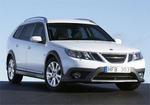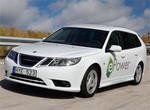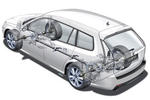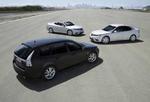
The 2008 Saab 93 range was launched today in Australia with a choice between renewable bioethanol, economical diesel or petrol powered engines.
The price for the 2008 Saab 93 Sport Sedan starts at $43,400 and goes up to $73,100 for the Aero 2.8TS with 188 kW, 350 Nm of torque and automatic transmission.
The price for the 2008 Saab 93 SportCombi starts at $45,900 and goes as high as $75,600 for the 2008 Saab Aero 2.8TS with 188 kW, 350 Nm of torque and automatic transmission.
The 2008 Saab 93 Convertible price for Australia starts at $65,500 and goes up to $93,300
for the 2008 Saab Aero 2.8TS with 188kW, 350 Nm of torque and automatic transmission.
Saab Press Release:
New Saab 9-3 range Renewable, Economical, Responsible
Saab today launched the new 9-3, the first range of vehicles in Australia to give drivers a choice of either renewable bioethanol, economical diesel or petrol powered engines.


Last month, Saab Australia became the first car maker to produce a renewable, bioethanol powered car for the Australian market with Saab 9-5 BioPower going on sale.
Today's 9-3 launch adds three more E85 flex-fuel vehicles to its environmentally friendly line-up. Saab 9-3 BioPower will be available in Sport Sedan, SportCombi and the iconic Saab Convertible. It is priced at a $1,000 premium over its equivalent petrol model and is on sale immediately.
Coinciding with the introduction of 9-3 BioPower,
Australia's largest independent fuel retailer, United Petroleum, has announced plans to install Australia's first commercial E85 fuel pumps - one in Sydney and one in Melbourne.
Saab estimates driving on E85 can reduce fossil fuel-based CO2 emissions by up to 80 per cent. The most efficient small capacity diesel engines deliver in the region of 120-130 grams of fossil CO2 per kilometre, while the new 9-3 BioPower emits just 40 grams of fossil CO2 per kilometre - with even better performance.
Praising United Petroleum for its support of renewable fuels, Director GM Premium Brands, Parveen Batish, said United's commitment to E85 would change the face of transport in Australia.
"With the launch of BioPower, Saab set out to break the chicken and egg cycle that prevented Australian drivers from choosing a renewable fuel alternative," Mr Batish said.
"Saab took the first leap and United Petroleum is taking the same bold leadership position with its commitment to make E85 commercially available to flex-fuel car drivers.
"This is a big investment by United Petroleum. We think with this support BioPower will be a
success in Australia and will stimulate other manufacturers to bring their flex-fuel vehicles to this country as well. This is the tip of the iceberg," Mr Batish said.
"With a bioethanol model, a powerful and economical diesel and a carbon off-set through Greenfleet for every new car we sell, the Saab 9-3 range really does deliver on our promise of performance with responsibility."
2.0t BioPower
The Saab 9-3 BioPower launched today is a flex-fuel ethanol powered version of the 9-3 range which can run on E85 - a mix of 85 per cent ethanol and 15 per cent petrol - or petrol, in any combination, from the one fuel tank.
Already the best selling environmentally friendly vehicle in Sweden, Saab 9-5 BioPower is leading Europe's emerging flex-fuel segment. Setting it apart from its flex-fuel competitors, BioPower combines turbocharging with the use of E85 fuel to deliver increased engine power and performance, as well as greatly reduced fossil CO2 emissions.
The Saab 9-3 BioPower engine delivers peak power of 147kW and 300Nm of maximum torque on E85. Running on E85 the BioPower 2.0t engine produces at least an additional 18kW (147kW vs 129kW) and an extra 35Nm of torque (300Nm vs 265Nm) over the 2.0-litre turbo petrol variant.
Progressive Design
The distinctive new styling of 9-3 Sport Sedan, SportCombi and Saab's iconic Convertible, is inspired by Saab's award-winning Aero X concept car, reinforcing the range's sporty appeal and performance focus.
The new 9-3 is visually distinguished by all-new bodywork forward of the A-pillar, with new bumper mouldings and light assemblies front and rear, as well as new doors and handles for the Sport Sedan and SportCombi. Flared side sill extensions become standard across the range.
All these elements combine to give the car a clearer Saab identity and a bolder, more assertive stance. For the Sport Sedan, for example, 70 per cent of the external body panels and parts are all-new.
The styling strategy brings together contemporary and classic Saab design themes in a progressive, modern expression of the brand's distinctive character.
The deeper, more prominent evolution of the Saab grille adopts a theme first seen on the Aero X concept car. This is complemented by all-new headlamp lenses and light units that now incorporate a thin 'eyebrow' lighting zone designed as a brand specific 'signature' feature.
These wraparound units culminate in an upswept rear edge, introducing a Saab design theme from the 9-5 range and classic 900 model. The grille's central wing motif, referencing Saab's aircraft heritage, is, of course, retained.
The new look sees the adoption of another Saab signature feature: a 'clamshell' hood, closing across the top of the front wings. The hood pressing incorporates a sweeping, U-shaped styling line, as first seen on the Aero X, which echoes the curvature of the windshield.
The swept-back frontal lines are complemented by a front bumper and splitter assembly with a deep, trapezoidal air intake, even more pronounced on Aero versions. This is flanked by deep black vents which are framed, like the grille, in a matte chrome finish. As with the Aero X concept, these represent a metaphor for the intakes of a jet engine.
At the rear, the Sport Sedan and Convertible now feature smoked white light clusters. The new bumper mouldings are much deeper with curved, uninterrupted surfaces. The trunk lids of the Sport Sedan and Convertible are also altered to accommodate a new matte chrome life handle trim with an integrated badge, similar that on the SportCombi.
The removal of all external rubbing strips from bumpers and doors (colour-keyed on the Convertible) contributes to a cleaner and more cohesive overall appearance. New door panels now adopt a simple, uncluttered form with redesigned and colour-keyed handles. The sill extensions are visually integrated front and rear with the scalloped corners of the new bumper mouldings.
Other external enhancements include the introduction of flat wiper blades, for reduced wind noise, and new alloy wheels, with an 18-inch design now offered as an option on all variants. Two new colours are added to the range, including a Snow Silver metallic paint finish similar to that seen on the Aero X.
As well as adding a BioPower model to the Saab line-up in Australia, the new 9-3 range will also introduce all-wheel drive and new performance diesel models in 2008.
From February, TTiD, an innovative 132kW, two-stage 1.9 litre performance turbo diesel will be available, joined by the exciting new limited edition Turbo X, all-wheel drive performance car in June.
Responsible performance - new 1.9 TTiD engine
TTiD is a powerful new four cylinder diesel engine with a unique two-stage turbocharging system, a world 'first' in the premium car segment, giving class-leading levels of efficiency.
The 1.9-litre, 16-valve engine produces 132 kW and 400Nm (manual only) of maximum torque, specific power outputs that are unmatched among competitor products on the market. With combined fuel consumption of 5.9 l/100km projected for the Sport Sedan, this engine also offers class-leading economy, together with in-gear performance on a par with the 2.8V6 turbo petrol engine.
The two-stage turbocharger housing is integrated with the exhaust manifold and contains two turbochargers of different sizes. The pair of turbine/compressor wheels are sequentially mounted and each is able to by-pass the input and output feeds of the other, while also being able to operate in tandem.
In recognition of its outstanding performance, the Saab TTiD engine will only be available in Aero specification. It will be offered initially in Sport Sedan and SportCombi, in addition to the current 110 kW 1.9 TiD engines, with a choice of six-speed manual or six-speed automatic transmissions.
Turbo X
The active, all-wheel-drive system (Saab XWD) is designed to optimise handling and stability in all driving conditions. It is fitted as standard on the Turbo X Limited Edition 9-3 Sport Sedan and SportCombi which is due in Australia around June 2008.
Turbo X combines XWD with an up-rated 206kW, 2.8V6 Turbo engine which delivers almost 15 per cent more maximum torque to 400Nm to exploit the greater traction available. It comes with a choice of six-speed manual or six-speed automatic transmission.
Optional cornering bi-xenon headlights provide improved vision. The steering-linked bulbs can swivel up to 15 degrees when negotiating a bend or corner above 15km/h. In highway driving above 110km/h, the low beam is also automatically raised slightly for improved illumination. Preliminary performance figures of 0-100km/h in 5.7 seconds have been recorded for the manual version.
New model line-up
Saab Australia is also introducing a change to the levels of specification within the 9-3 range. Previously additional trim and luxury appointments between Linear, Vector and Aero were accompanied by requisite increases in performance specification.
For the new model year, customers will be able to match levels of comfort and luxury specification in Linear and Vector with the petrol, flex-fuel or diesel engine combination of their choice. (Model list included below.)
Entry model Linear is standard with 2.0-litre turbocharged 129kW engine and the 9-3 Aero will also offer an additional 4kW, taking maximum power to 188 kW.
New 9-3 also adds a new standard 17 x 7.5 inch alloy wheel, dynamic new 18-inch optional wheel on Aero and Linear vehicles also gain a new 16 x 6.5 inch alloy.
The new 9-3 Aero model includes a new Bose Centerpoint Surround Sound audio, which is also available as an option for Linear and Vector Sport Sedan and SportCombi. The Bose system offers exceptional reproduction quality through five channels from CD, MP3 and other audio sources. Surround sound quality is automatically provided even if a CD is not encoded for it. With 11 (Sedan) or 10 (Combi) speakers, performance is optimised for the acoustic requirements of each passenger cabin.














